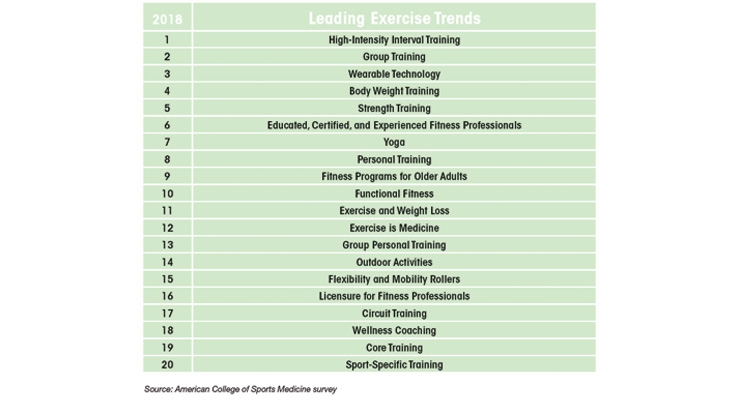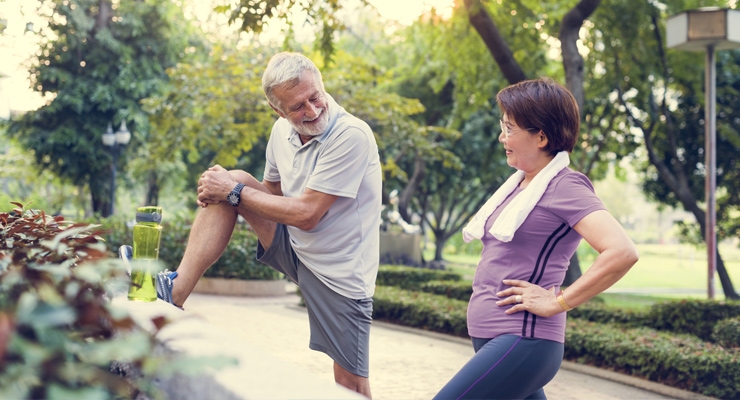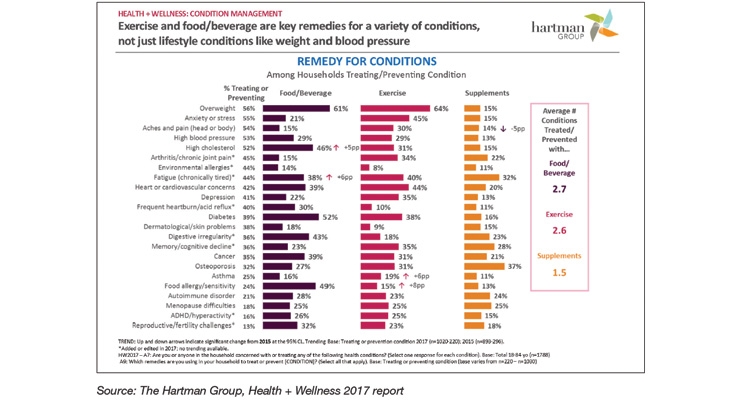By Dr. A. Elizabeth Sloan & Dr. Catherine Adams Hutt, Sloan Trends, Inc.03.01.18
With a new demographic of super active consumers who consciously integrate physical exercise into their everyday routines—the oldest boomers now topping age 70—and millions of workers in physically demanding jobs trying to build muscle/strength/stamina, nutraceuticals and natural solutions that help consumers move more freely and stay pain-free will continue to be in high demand.
While being able to maintain normal activity/mental sharpness with age is by far the top health concern of those aged 50 and older in the U.S. and around the world, younger adults tend to focus more on improving their everyday well-being and performance. Fifty-one percent of younger consumers are very/extremely concerned about back/neck pain, 49% bone health/strength, 46% muscle health/muscle tone, and 39% joint pain.
Getting a Move On
Just over half (53%) of American adults exercised regularly last year, according to Mintel’s October 2017 “Healthy Lifestyles – U.S.” Those under age 40 are most likely to do so. Exercise is growing fastest among those age 65 and older.
Exercise is now the most frequently chosen first step when trying to prevent many health problems, including issues of the heart, cognition, weight, fatigue, anxiety/stress, and joint pain/arthritis, per the Hartman Group’s 2017 Health + Wellness report (see Figure 1).

Per the National Sporting Goods Association’s 2017 “Sports Participation in the US,” walking is the top sport/exercise activity (with 106 million participants), followed by exercising with equipment (56 million), swimming (46 million), aerobic exercising (45 million), and jogging (44 million). One in five exercisers regularly include yoga and/or Pilates in their fitness regimen, 19% cardio machines/cycling/spinning, and 18% elliptical/stair/rowing equipment, per Mintel.
More so than the general population, exercisers are much more interested in looking better (44%), toning muscles (39%), and losing weight (36%). Improvements in body composition (46%) and fitness level (39%) are the top motivators to keep up their exercise regimens, per Mintel.
Only 30% of those aged 18-34 and 26% aged 25-34 meet the National Institutes of Health’s (NIH) guidelines for muscle strengthening activities. Muscle/strength building and weight loss are the top two reasons Americans buy personal fitness products, per ECRM/HellaWella’s 2016 consumer survey.
Not surprisingly, body weight and strength training, as well as flexibility (e.g., yoga) have made it into the top 10 hot global exercise trends for 2018, according the American College of Sports Medicine’s annual global survey of exercise professionals (see Figure 2).

Conditional Mobility
Arthritis is the leading cause of disability in the U.S. and the condition responsible for the most lost work days. One in four adults, or 54 million Americans, have doctor-diagnosed arthritis; 31 million osteoarthritis, per the Arthritis Foundation. Two-thirds of those with arthritis are under age 65.
Half (49%) of those with arthritis also have heart disease, 47% diabetes, 44% high blood pressure, and 31% are also obese. Although Blacks and Hispanics have a lower incidence of arthritis, they experience more severe pain.
Lower back pain was the type of physical pain most often suffered by 58% of U.S. adults in 2016, followed by joint pain/soreness 50%, muscle pain 44%, neck pain/soreness 38%, foot pain 31%, and 24% hand or wrist pain, per Packaged Facts’ January 2017 “Pain Management in the U.S.” Low back pain accounted for 58% of pain limiting their everyday function.
Leisure activities, sports, and work around the house contribute to 18 million sprains per year, mostly among those aged 18-44, per the Centers for Disease Control and Prevention’s (CDC) 2017 “Musculoskeletal Report.”
Four in 10 consumers took a supplement for minor, everyday pain vs. 60% an OTC product, per Packaged Facts; 7% visited an acupuncturist for pain, 5% a chiropractor, and 5% a massage therapist.
In 2017, sales of joint supplements reached $1.7 billion, up 1.6%, per Nutrition Business Journal (NBJ); omega-3 fish oils reached $1.2 billion.
According to the Council for Responsible Nutrition’s (CRN) 2017 Consumer Supplement Survey, 16% of supplement users take them for joint health; 23% aged 55 and older; 9% of supplement users took glucosamine and/or chondroitin; 13% of those aged 55 and older.
One in five used pain-relieving rubs, liquids/wraps; 16% for backaches, 10% arthritis pain, and 7% sport/exercise pain, per Packaged Facts.
Obesity also limits exercise; 165 million Americans are overweight and 86 million obese, per 2017 statistics from the American Heart Association.
Aging
Concerns about mobility start to appear at ages 50-64 when there is an awareness of muscle and bone loss with aging.
According to a 2016 Abbott/AARP survey, 70% of adults age 50 and older are aware of losing muscle with age; 34% are extremely concerned. More than 60% said their top concern about muscle loss was decreased mobility, loss of strength, and loss of independence; 50% cited being less active and the ability to fight infections as top issues. One in two adults 55 years and older wished they had more strength/energy to participate in the activities they enjoy.
Seven in 10 would increase their protein intake to minimize the risk of losing muscle/lean body mass. One in four over age 50 said their doctor had talked to them about muscle loss.
Loss of strength (40%) and muscle loss (21%) were also among the top concerns of the 35% of those aged 50 and older who had been hospitalized with a serious/chronic health condition, per Abbott.
In the U.S., 45% of those over 65 years old already have sarcopenia, defined by low muscle mass and low muscle quality/function. Only 17% meet the NIH Muscle Strength guidelines, 13% age 75 and older. Over half (55%) of those over age 50 have trouble rising from a chair (without arms).
Globally, more than 50% of those over 80 years have sarcopenia, per the World Health Organization (WHO). One-third of adults over age 70 fall every year.
Osteoporosis is projected to rise among men age 70 and older, according to the NIH. One in two women and one in five men over 50 years will suffer osteoporotic fractures.
Calcium supplements are projected to top $1.2 billion, according to NBJ, up a mere 0.4% in 2018. One-quarter of supplement users take supplements for bone health; 17% of men, 28% of women, and 32% aged 55 and older.
Mobility is the most common disability among those age 65 and older; 15.7 million have difficulty walking/climbing stairs. Three-quarters of adults define old age by not being able to live independently anymore; 45% by having trouble walking up the stairs.
The proportion of current users of assistive devices/technology increases with age, from 20% at age 70 to 90% at age 90, per WHO.
Food & Beverages
Two-thirds of consumers are looking to foods/beverages to help build their physical strength/muscle, according to FMI’s 2016 Shopping for Health report. Just over half of millennials (53%) associated meat with building physical strength/muscle; 42% poultry, according to FMI’s Power of Meat report.
In 2017, 37% of adults consumed sports drinks. Packaged Facts estimated that sales of sports and energy drinks will reach $23 billion in sales, up 5% in 2018 (Energy and Sports Drinks, May 2017); hardcore sports beverages are over $900 million, up 15%; weight loss meal supplements will reach $4.1 billion in 2018; nutrition bars $6 billion, up 12% in 2018.
Protein remains an essential part of the mobility mix (Sloan and Adams Hutt, “Emerging Market Opportunities for Next Generation Proteins,” Nutraceuticals World, October 2017).
Dietary Supplements
Sales of sports nutrition supplements will reach $5 billion in 2018, per NBJ, up 6.7%; sports nutrition powder $5.4 billion, up 6.6% in 2018. One-quarter of supplement users take protein supplements; 39% of those aged 18-34; 21% age 35-54; 13% age 55 and older, per CRN.
Four in 10 consumers are looking for supplements that help develop heathier muscle/tone; 38% healthier/stronger bones; while 36% want to help maintain bone, joint, and muscle integrity, per HealthFocus.
While being able to maintain normal activity/mental sharpness with age is by far the top health concern of those aged 50 and older in the U.S. and around the world, younger adults tend to focus more on improving their everyday well-being and performance. Fifty-one percent of younger consumers are very/extremely concerned about back/neck pain, 49% bone health/strength, 46% muscle health/muscle tone, and 39% joint pain.
Getting a Move On
Just over half (53%) of American adults exercised regularly last year, according to Mintel’s October 2017 “Healthy Lifestyles – U.S.” Those under age 40 are most likely to do so. Exercise is growing fastest among those age 65 and older.
Exercise is now the most frequently chosen first step when trying to prevent many health problems, including issues of the heart, cognition, weight, fatigue, anxiety/stress, and joint pain/arthritis, per the Hartman Group’s 2017 Health + Wellness report (see Figure 1).

Per the National Sporting Goods Association’s 2017 “Sports Participation in the US,” walking is the top sport/exercise activity (with 106 million participants), followed by exercising with equipment (56 million), swimming (46 million), aerobic exercising (45 million), and jogging (44 million). One in five exercisers regularly include yoga and/or Pilates in their fitness regimen, 19% cardio machines/cycling/spinning, and 18% elliptical/stair/rowing equipment, per Mintel.
More so than the general population, exercisers are much more interested in looking better (44%), toning muscles (39%), and losing weight (36%). Improvements in body composition (46%) and fitness level (39%) are the top motivators to keep up their exercise regimens, per Mintel.
Only 30% of those aged 18-34 and 26% aged 25-34 meet the National Institutes of Health’s (NIH) guidelines for muscle strengthening activities. Muscle/strength building and weight loss are the top two reasons Americans buy personal fitness products, per ECRM/HellaWella’s 2016 consumer survey.
Not surprisingly, body weight and strength training, as well as flexibility (e.g., yoga) have made it into the top 10 hot global exercise trends for 2018, according the American College of Sports Medicine’s annual global survey of exercise professionals (see Figure 2).

Conditional Mobility
Arthritis is the leading cause of disability in the U.S. and the condition responsible for the most lost work days. One in four adults, or 54 million Americans, have doctor-diagnosed arthritis; 31 million osteoarthritis, per the Arthritis Foundation. Two-thirds of those with arthritis are under age 65.
Half (49%) of those with arthritis also have heart disease, 47% diabetes, 44% high blood pressure, and 31% are also obese. Although Blacks and Hispanics have a lower incidence of arthritis, they experience more severe pain.
Lower back pain was the type of physical pain most often suffered by 58% of U.S. adults in 2016, followed by joint pain/soreness 50%, muscle pain 44%, neck pain/soreness 38%, foot pain 31%, and 24% hand or wrist pain, per Packaged Facts’ January 2017 “Pain Management in the U.S.” Low back pain accounted for 58% of pain limiting their everyday function.
Leisure activities, sports, and work around the house contribute to 18 million sprains per year, mostly among those aged 18-44, per the Centers for Disease Control and Prevention’s (CDC) 2017 “Musculoskeletal Report.”
Four in 10 consumers took a supplement for minor, everyday pain vs. 60% an OTC product, per Packaged Facts; 7% visited an acupuncturist for pain, 5% a chiropractor, and 5% a massage therapist.
In 2017, sales of joint supplements reached $1.7 billion, up 1.6%, per Nutrition Business Journal (NBJ); omega-3 fish oils reached $1.2 billion.
According to the Council for Responsible Nutrition’s (CRN) 2017 Consumer Supplement Survey, 16% of supplement users take them for joint health; 23% aged 55 and older; 9% of supplement users took glucosamine and/or chondroitin; 13% of those aged 55 and older.
One in five used pain-relieving rubs, liquids/wraps; 16% for backaches, 10% arthritis pain, and 7% sport/exercise pain, per Packaged Facts.
Obesity also limits exercise; 165 million Americans are overweight and 86 million obese, per 2017 statistics from the American Heart Association.
Aging
Concerns about mobility start to appear at ages 50-64 when there is an awareness of muscle and bone loss with aging.
According to a 2016 Abbott/AARP survey, 70% of adults age 50 and older are aware of losing muscle with age; 34% are extremely concerned. More than 60% said their top concern about muscle loss was decreased mobility, loss of strength, and loss of independence; 50% cited being less active and the ability to fight infections as top issues. One in two adults 55 years and older wished they had more strength/energy to participate in the activities they enjoy.
Seven in 10 would increase their protein intake to minimize the risk of losing muscle/lean body mass. One in four over age 50 said their doctor had talked to them about muscle loss.
Loss of strength (40%) and muscle loss (21%) were also among the top concerns of the 35% of those aged 50 and older who had been hospitalized with a serious/chronic health condition, per Abbott.
In the U.S., 45% of those over 65 years old already have sarcopenia, defined by low muscle mass and low muscle quality/function. Only 17% meet the NIH Muscle Strength guidelines, 13% age 75 and older. Over half (55%) of those over age 50 have trouble rising from a chair (without arms).
Globally, more than 50% of those over 80 years have sarcopenia, per the World Health Organization (WHO). One-third of adults over age 70 fall every year.
Osteoporosis is projected to rise among men age 70 and older, according to the NIH. One in two women and one in five men over 50 years will suffer osteoporotic fractures.
Calcium supplements are projected to top $1.2 billion, according to NBJ, up a mere 0.4% in 2018. One-quarter of supplement users take supplements for bone health; 17% of men, 28% of women, and 32% aged 55 and older.
Mobility is the most common disability among those age 65 and older; 15.7 million have difficulty walking/climbing stairs. Three-quarters of adults define old age by not being able to live independently anymore; 45% by having trouble walking up the stairs.
The proportion of current users of assistive devices/technology increases with age, from 20% at age 70 to 90% at age 90, per WHO.
Food & Beverages
Two-thirds of consumers are looking to foods/beverages to help build their physical strength/muscle, according to FMI’s 2016 Shopping for Health report. Just over half of millennials (53%) associated meat with building physical strength/muscle; 42% poultry, according to FMI’s Power of Meat report.
In 2017, 37% of adults consumed sports drinks. Packaged Facts estimated that sales of sports and energy drinks will reach $23 billion in sales, up 5% in 2018 (Energy and Sports Drinks, May 2017); hardcore sports beverages are over $900 million, up 15%; weight loss meal supplements will reach $4.1 billion in 2018; nutrition bars $6 billion, up 12% in 2018.
Protein remains an essential part of the mobility mix (Sloan and Adams Hutt, “Emerging Market Opportunities for Next Generation Proteins,” Nutraceuticals World, October 2017).
Dietary Supplements
Sales of sports nutrition supplements will reach $5 billion in 2018, per NBJ, up 6.7%; sports nutrition powder $5.4 billion, up 6.6% in 2018. One-quarter of supplement users take protein supplements; 39% of those aged 18-34; 21% age 35-54; 13% age 55 and older, per CRN.
Four in 10 consumers are looking for supplements that help develop heathier muscle/tone; 38% healthier/stronger bones; while 36% want to help maintain bone, joint, and muscle integrity, per HealthFocus.






























